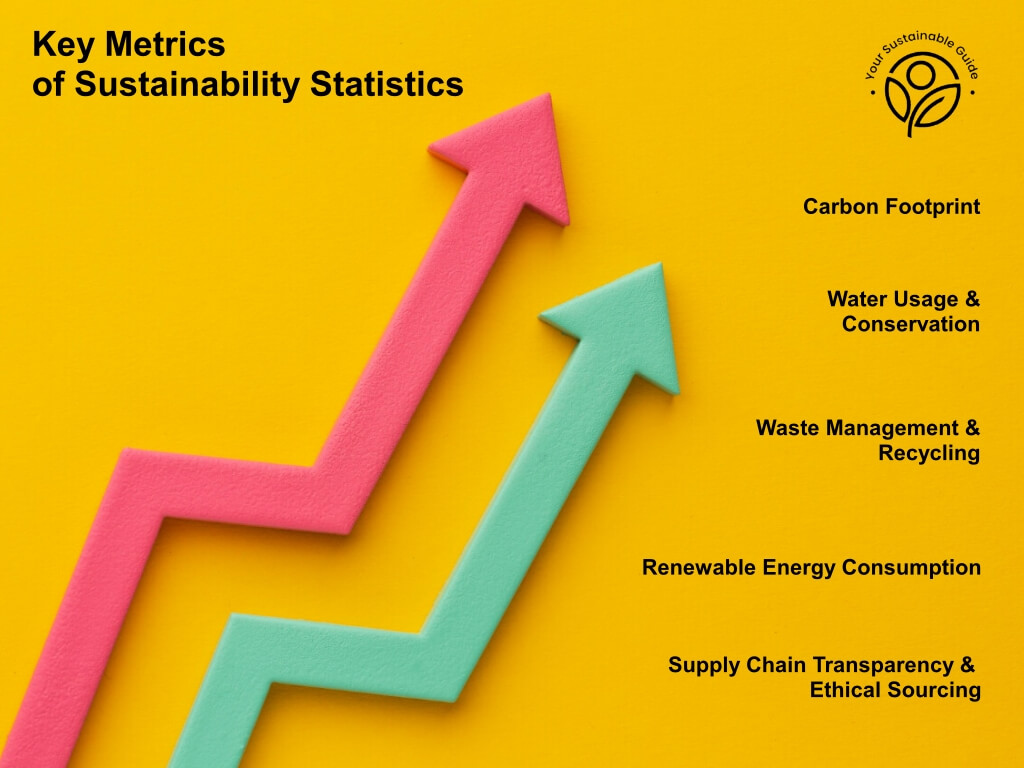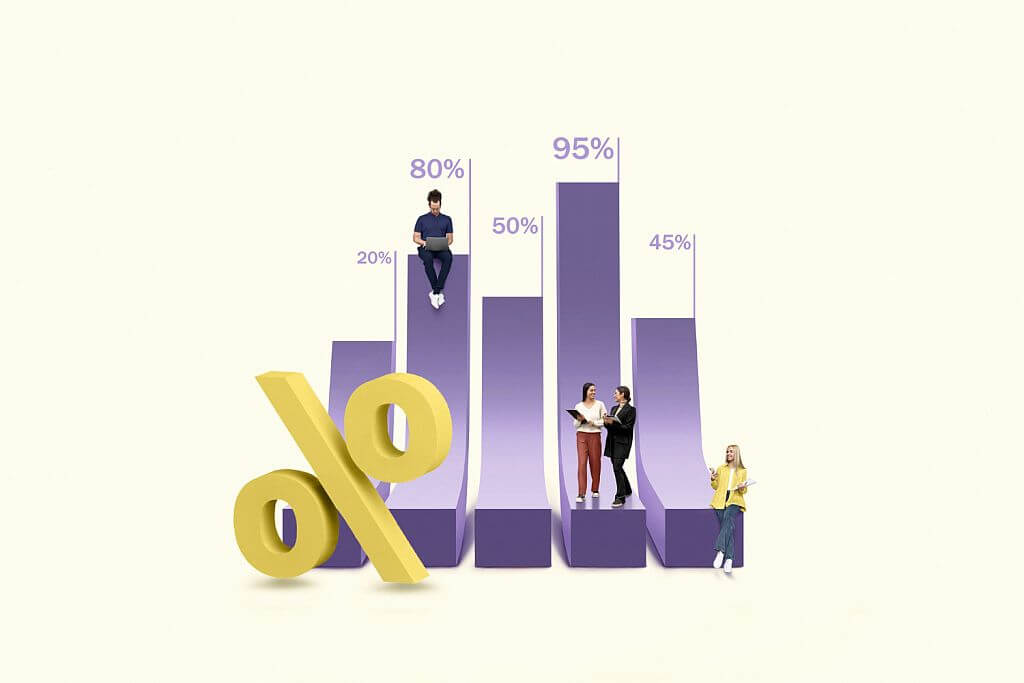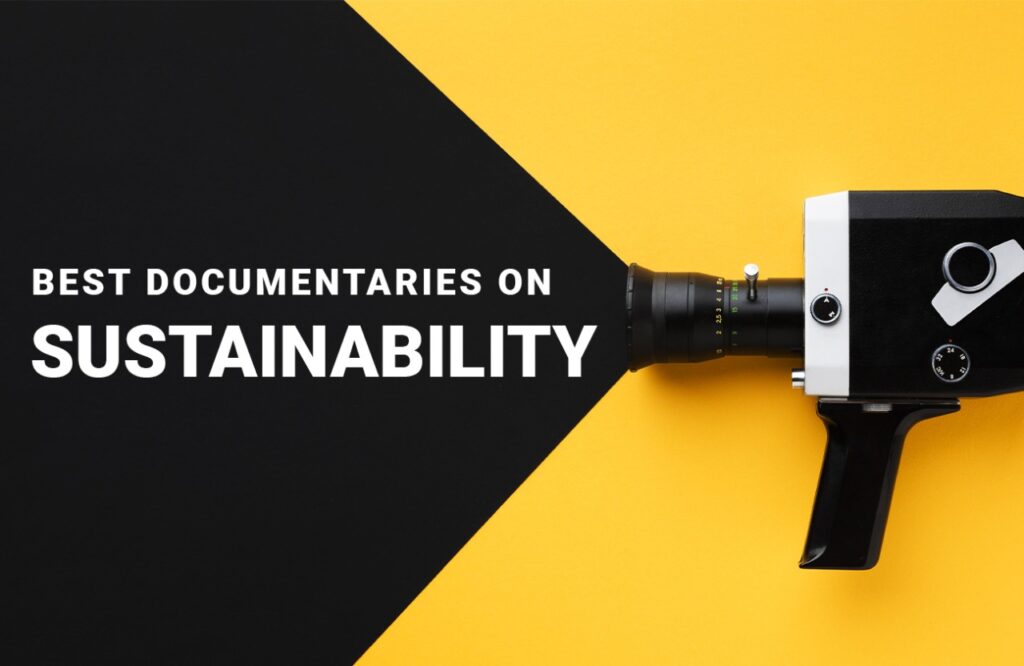Sustainability is a journey! It’s a powerful concept that teaches how to balance our needs while preserving the planet’s resources for future generations. Today, the surge in climate crisis calls for action from Everybody— organizations, government bodies, and individuals alike, to restore the glory of Mother Earth! Thankfully, sustainability statistics can guide our path to assess our environmental footprint.
Humankind’s reckless habits are taking a toll on our ecosystems. While pollution clouds the skies, numerous species go extinct, and carbon emissions soar, leaving a trail of damage. And if we don’t change, clean water, fresh air, and abundant food could soon become luxuries. So, let’s stand as eco-guardians by embracing sustainability tips as part of our lifestyle and staying updated with the latest sustainability stats to build a greener planet!
Sustainability Statistics: Key Metrics

Organizations striving for sustainability should focus on several essential metrics to gauge their environmental impact and steer in continuous improvement.
Carbon Footprint
Measuring the total greenhouse gas emissions, such as carbon dioxide (CO2), methane, and nitrous oxide, is vital for companies to understand their contribution to climate change. Tracking and reducing carbon emissions can help identify high-impact areas and implement strategies to lower the carbon footprint, such as energy efficiency measures and transitioning to renewable energy sources.
Water Usage and Conservation
Monitoring water usage helps businesses comprehend water-related risks and impacts on water resources. Efficient water management practices, like water recycling and conservation efforts, can minimize water consumption and promote responsible water stewardship.
Waste Management and Recycling
Assessing waste generation and diversion rates enables corporations to identify opportunities for waste reduction, recycling, and circular economy initiatives. Implementing efficient waste management practices not only reduces environmental impact but also optimizes resource use and reduces landfill contributions.
Renewable Energy Consumption
Measuring the proportion of energy sourced from renewables is crucial for businesses aiming to shift towards green energy sources. Transitioning to solar or wind power helps reduce reliance on fossil fuels and supports a low-carbon functioning.
Supply Chain Transparency and Ethical Sourcing
Evaluating the sustainability performance of suppliers results in transparency and accountability throughout the supply chain. Companies should emphasize on ethical sourcing practices, including fair labor conditions, human rights, and environmental responsibility, to mitigate reputational risks and nurture positive social and environmental impacts.
Key Sustainability Stats
Global Environmental Sustainability Statistics

- Global temperatures have consistently reached record highs, posing significant climate risks, including rising sea levels, melting arctic ice, and more weather-related catastrophes | Statista
- A small number of industrial facilities in Europe contribute to 50% of air pollution-related damage | European Environment Agency
- Out of the 41.9 million tons of paper containers produced, an impressive 80.9% are recycled, contributing to sustainable waste management efforts | Environmental Protection Agency
- Embracing sustainable packaging design has the potential to significantly decrease greenhouse gas emissions by approximately 3.8 million, further supporting environmental sustainability goals | ReFED
- Air pollution from large industrial sites in Europe cost society between €277 and €433 billion in 2017 | European Environment Agency
- By 2030, businesses have the potential to cut greenhouse gas emissions globally by 3.7 billion metric tons, equivalent to 60% of the emission cuts pledged in the Paris Agreement | United Nations
- As per records, the global populations of animals, including birds, fishes, mammals, reptiles, etc., have declined by 68% over the past 50 years, reflecting a severe loss in biodiversity | United Environment Programme
- Every year, over 300 million metric tons of plastic waste are generated, with the packaging industry being responsible for half of this waste. The textile sector is the second-largest contributor to overall plastic waste production | Statista
- Inefficient production and use of natural resources are the primary causes of biodiversity loss | United Environment Programme
- The extraction and processing of biomass (crop cultivation, leftover plant materials, harvested timber, wild-caught fish, etc.) are responsible for over 80% of land-use-related biodiversity loss | UN Environment Programme
- In 2022, the United States emerged as the leading country in issuing sustainable bonds, encompassing both government and domestically-based organizations, with a value exceeding 104 billion U.S. dollars. France ranked second with almost 90 billion U.S. dollars, followed closely by China with 88 billion U.S. dollars | Statista
- Approximately 5 million hectares of forest are lost each year, mainly driven by the industrial production of beef, soybeans, palm oil, and paper/wood | Our World In Data
- Renewable energy accounted for 17% of the world’s energy consumption in 2017 | Sustainable Development Goals
- In order to prevent severe climate-related consequences, worldwide greenhouse gas emissions must reach their highest point before 2025 and then decrease by 43 per cent by 2030. However, existing national commitments indicate a projected increase of nearly 14 per cent by 2030, emphasizing the necessity for more ambitious efforts to achieve the target set at 1.5 °C | Sustainable Development Goals
- The per-capita landfill rate decreased from 3.2 to 2.4 pounds between 1990 and 2018 | Environmental Protection Agency
- Humankind is projected to produce 27 billion tons of municipal solid waste by 2050 | Springer Link
- Plastic pollution and overfishing endanger two-thirds of the planet’s marine ecosystems | United Environment Programme
- Collection rates for electronic waste (e-waste) are considerably higher in high-income countries compared to low- and middle-income countries. In sub-Saharan Africa, the collection rate stands at a mere 1.6 %, while in Latin America and the Caribbean, it is even lower at 1.2 % | United Nations
- Each day, an astounding 500 million plastic straws are consumed worldwide, highlighting the enormous scale of plastic waste generated | National Geographic
- Plastic ranks as the second most prevalent item discarded in landfills, emphasizing the urgent need for sustainable waste management solutions | Environmental Protection Agency
- The majority of greenhouse gas emissions originate from a limited number of countries. The United States, European Union (EU), China, Russia, Japan, India, and Canada, known as the seven largest emitters, were responsible for over 70% of energy-related CO2 emissions in 2004 | Environmental Protection Agency
- Denmark topped the list of the most eco-friendly countries in the world | The RoundUp
Corporate Sustainability Statistics

- Around 30% of major companies in Europe have made commitments to achieve Net-Zero emissions by 2050 | Accenture
- Approximately 22.8% of Fortune 500 corporations have engaged with the UN’s Sustainable Development Goals (SDGs), but only a small fraction have implemented methods to measure their progress towards these goals | Science Direct
- In a global study of 850 companies, 80% expressed their intention to increase investments in sustainability |. WeWork
- The number of companies publishing Corporate Social Responsibility (CSR) reports on the S&P 500 index has risen from 20% in 2011 to approximately 90% in 2019 | Harvard Business School
- More than 4500 companies worldwide have received B Corp certification, demonstrating their commitment to high standards of social and environmental performance | B.LAB
- In a new survey, 83% of investment professionals and C-suite executives anticipate that ESG programs will yield greater shareholder value in the next five years compared to their current impact | McKinsey
- About 72% of businesses recognize the risks the climate crisis poses to their operations, revenue, or expenditures | Harvard Business Review
- Today, over 90% of CEOs consider sustainability vital to their company’s success | Stanford Social Innovation Review
- In 2022, the majority of real estate investors relied on sustainability certification programs like LEED, BREEM, or NABERS to assess the sustainability credentials of buildings and enhance marketing efforts | Statista
- 88% of these studies demonstrate that integrating strong ESG practices into business strategies leads to improved operational performance | Harvard Business Review
- Currently, a limited portion of Italian e-commerce companies have adopted sustainable business practices and strategies. According to a 2023 survey of Italian professionals, 26 percent of online retailers incorporated sustainable products, recyclable packaging, and more environmentally friendly material usage. Conversely, only 17 percent of companies committed to reducing carbon emissions | Statista
- Companies that prioritize both sustainability and innovation outperform industry peers, with 3.1% higher operating profits and greater returns for shareholders | Accenture
- In 2021, 74% of institutional investors expressed a preference for disposing of companies with poor sustainability performance | IMD
- A recent study reveals a strong connection between resource efficiency and financial performance, with companies improving operating profits by up to 60% through resource cost reduction | McKinsey
- More than 70% of employees at major U.S. companies are inclined to work for organizations with a robust environmental agenda | Fast Company
Consumer Sustainability Statistics

- During 2022, the majority of global consumers observed a shift towards more environmentally conscious purchasing habits compared to five years ago. More than one-third of surveyed shoppers acknowledged a slight change, while almost 30% reported a significant increase in buying sustainable products | Statista
- A significant 69% of consumers prioritize sustainable packaging as their top concern, highlighting its crucial role in meeting consumer expectations | Deloitte
- On average, 64% of consumers actively seek ways to reduce their usage of plastic packaging, indicating a growing consciousness of environmental impact | Deloitte
- An impressive 83% of consumers belonging to the younger generations are willing to pay a premium for products with sustainable packaging, demonstrating their commitment to making eco-friendly choices | Trivium Packaging
- Consumer behavior is shifting positively, with 75% supporting a ban on single-use plastic, reflecting a desire for more sustainable alternatives | Reuters
- In the UK, 64% of consumers took steps to limit their consumption of single-use plastic in 2021, showcasing a 3% increase compared to the previous year | Deloitte
- Purpose-driven shoppers, averaging 70%, are willing to pay a premium of 35% for sustainable purchases, demonstrating their commitment to reducing environmental impact | IBM
- Nearly 63% of Americans look up to responsible businesses to lead the way in driving social and environmental change towards a more sustainable future | Cone Communications
- Over half, that is, 55% of American consumers, believe it is important for companies to take a stance on critical social, environmental, and political issues | Harvard Business School
- The loyalty of 88% of consumers is more likely to be retained by companies that actively support social or environmental causes, highlighting the importance of corporate responsibility | Forbes
- 50% of conscious consumers consider sustainability as one of the top five important factors when choosing a brand | Simon Kucher
- In 2022, despite the global desire of consumers to contribute to environmental protection, a significant number of them believe that the current cost of living hinders their efforts. Roughly two-thirds of consumers worldwide expressed the wish to do more, but cited the cost of living as a barrier. This sentiment was particularly prominent in countries such as Brazil and India | Statista
Food Sustainability Statistics

- Approximately one-third of the food produced worldwide is wasted due to spoilage or rotting. This occurs during a period when billions of people are experiencing hunger and suffering from starvation | United Nations
- Food that ends up in landfills contributes up to 10% of global greenhouse gas emissions | Panda.org
- Supply chains experience a loss of around 13.8% of the total food produced right after harvesting, due to mishandling | UN Sustainable Development Goals Report
- In the United States, out of the 63,130,000 tons of food generated in 2018, around 2,590,000 tons were composted | EPA: Food: Material-Specific Data
- Approximately 17 percent of the food that is accessible to consumers, amounting to 931 million metric tons, is lost or wasted at various stages, including households, food service establishments, and retail outlets | United Nations
- The percentage of food recycled or composted has witnessed a 15.2% increase from 1990 to 2018 | EPA Advancing Sustainable Materials Management
- In 2019, approximately 35% of food in the United States remained unsold or uneaten | ReFED
- Implementing centralized composting systems has the potential to divert over 13.8 million tons of food waste | ReFED
Water Usage & Conservation Statistics
- Approximately 59% of domestic wastewater undergoes safe treatment | UN Sustainable Development Goals Report
- Food wastage accounts for 14% of freshwater resource wastage | ReFED
- Water scarcity could result in the displacement of 700 million people worldwide by 2030 | World Health Organization
- Adopting a vegan diet has the potential to save up to 219,000 gallons of water per person each year due to the lower water footprint of vegetables compared to meat and dairy | PETA
- Choosing a shower over a bath can save 16 gallons of water per person per day | EPA Water Sense
- Installing water-efficient mechanisms, like dual flush and water-sense toilet fixtures, can reduce toilet water consumption by up to 60% | The 71percent.org
- Agriculture consumes 70% of the world’s freshwater resources, reaching up to 90% in rapidly developing nations | Food and Agriculture Organization
- Water usage is increasing by 1% annually | UN Water
- Nearly half of the global population resides in regions that experience water scarcity for at least one month per year | UNESDOC
- The Food and Agriculture Organization predicts a 5.5% rise in water withdrawals between 2008 and 2050 | UNESDOC
- The average American uses 101.5 gallons of water per day | Phila Gov
Gen Z & Millennials’ Approach to Sustainable Shopping
- Generation Z leads in making sustainability-first buying decisions, with three-quarters preferring sustainability over brand names | World Economic Forum
- Between 2021 and 2022, the number of UK adults reducing new product purchases increased by roughly 20% | Statista
- 90% of Generation X individuals are willing to spend 10% more on sustainable products | First Insight
- In a 2023 survey, a significant number of consumers emphasized that one of the key factors contributing to the sustainability of beauty products is the use of 100% natural ingredients. Additionally, approximately 45% of the participants from the United States highlighted the importance of cruelty-free products | Statista
- Climate change ranks as a top three concern for millennials and Generation Z, after the cost of living | Deloitte
- 24% of consumers consider themselves the most important factor in addressing the climate crisis | Simon Kucher
- 66% of consumers are more likely to buy products labeled as USDA-certified fair trade | Statista
Importance of Sustainability Statistics for Taking Informed Decisions

Understanding The Relevance
Sustainability statistics provide valuable insights into the environmental, social, and economic impacts of various activities taking place worldwide. These data offer a clear understanding of how our actions affect the planet and the economy. By highlighting the environmental footprint, resource consumption, and emissions associated with different practices, sustainability statistics empower individuals, businesses, and policymakers to identify areas of improvement and implement effective strategies for reducing their impact. Furthermore, these statistics shed light on social issues such as inequality, labor conditions, and community well-being, prompting us to prioritize equitable and ethical practices.
Setting Goals and Targets
Setting specific and measurable sustainability goals based on statistics is of utmost importance in driving meaningful change. This approach can help in tracking progress, holding ourselves accountable, and making informed decisions to address pressing environmental and social challenges. Aligning these goals with global frameworks like the Sustainable Development Goals (SDGs) provides a comprehensive roadmap for action. The SDGs offer a universal language and a holistic approach to sustainability, addressing interconnected issues such as poverty, climate change, inequality, and more. With relevant data as our guide, we can adopt actions that have substantial effects and contribute to the achievement of these global targets.
Benchmarking and Comparisons
Comparing sustainability performance against industry peers, competitors, or recognized standards provides to evaluate our sustainability efforts. Statistical comparisons allow us to understand our strengths, weaknesses, and opportunities, enabling us to learn from leaders and adopt best practices. This process of evaluation and comparison empowers us to innovate, track progress, and drive collective action towards a greener future. It motivates us to push boundaries, embrace new sustainability strategies, and exceed industry standards, ultimately making a lasting impact on the environment and society as a whole.
Data-driven Decision-making
Organizations can gain a competitive edge by leveraging the power of sustainability data. Through the integration of these inputs into strategies, policies, and operational practices, organizations can make more rational decisions that are based on evidence and insights. Sustainability statistics provide a comprehensive understanding of environmental, social, and economic impacts, enabling organizations to identify areas that need attention and set meaningful goals. By incorporating data into their decision-making processes, organizations can prioritize actions, allocate resources effectively, and create positive change that aligns with global sustainability frameworks. This amalgamation of data into strategies empowers corporations to make evidence-based decisions.
Stakeholder Engagement
Transparent reporting and effective communication of sustainability data foster trust and garner support. When every stakeholder, including employees, customers, investors, and communities, openly shares information on environmental initiatives, social responsibility, and economic impact, a commitment to responsible practices is demonstrated. Stakeholders are then able to make valid decisions, aligning their values with the organization’s sustainability efforts. This open dialogue encourages active engagement and collaboration, enabling everyone to actively participate and contribute to eco-friendly initiatives.
Monitoring Progress
Regularly tracking and analyzing sustainability data is vital for monitoring progress towards targetted goals. It allows organizations to assess their overall performance and make upcoming plans based on reliable information. Through the implementation of robust data management systems and using relevant performance indicators, corporations can ensure accurate assessments of their sustainability efforts. This data-driven approach enables to identify strengths, pinpoint areas for improvement, celebrate successes, and adjust strategies as needed. Just as a compass guides a traveler, sustainability statistics act as a compass for organizations, providing direction and insights. With reliable data and effective analysis, organizations can navigate the path to a more sustainable future.
Collaboration and Partnerships
Sharing the latest sustainability stats with stakeholders, industry peers, and partners fosters collaboration and inspires collective action. Open communication from organizations can build trust, encourage transparency, and strengthen relationships with stakeholders. Collaborative initiatives based on shared sustainability goals can drive systemic change, as joint efforts undoubtedly have a greater impact than individual actions. Through partnerships and knowledge exchange, businesses can learn from each other, implement best practices, and innovate together to address global challenges.
Incorporating Lifecycle Thinking
Sustainability stats guide decision-making at every stage of a product, service, or project’s lifecycle. From design to end-of-life, analyzing these data enables corporations to make better choices that consider environmental and social impacts. In the early stages of development, data-driven decisions can lead to eco-friendly designs, resource-efficient processes, and ethical sourcing of materials. As products or services move through production and distribution, tracking sustainability metrics helps identify opportunities to reduce waste, minimize carbon footprints, and support fair labor practices. When it comes to the end-of-life phase, statistics can help in formulating strategies for recycling, reusing, or responsibly disposing of materials, ensuring a circular economy approach.
Continuous Improvement
The true power of data involves recognizing its nature. It’s essential for organizations to continuously review and refine their policies, drawing insights from new data, emerging trends, and evolving best practices. By staying adaptable and responsive, businesses can navigate the ever-changing landscape of sustainability to drive positive impact. Regularly reassessing and updating strategies based on up-to-date information guarantees that organizations remain at the forefront of sustainability efforts, maximizing their potential for long-term success.
Reporting of Sustainability Statistics

Leading Sustainability Reporting Frameworks
- Task Force on Climate-related Financial Disclosures (TCFD): This framework was established by the Financial Stability Board (FSB) to help businesses disclose climate-related risks and opportunities in their financial reporting. TCFD provides guidelines for companies to assess and disclose information related to governance, strategy, risk management, and metrics related to climate change. Its goal is to enable investors, lenders, and other stakeholders to make informed decisions regarding climate-related impacts on organizations.
- Global Reporting Initiative (GRI): It is a widely recognized foundation that helps corporations report on their sustainability performance. GRI offers comprehensive guidelines for reporting environmental, social, and governance (ESG) aspects. It promotes transparency and comparability of sustainability data, allowing stakeholders to understand an organization’s impact on the environment, society, and economy.
- Sustainability Accounting Standards Board (SASB): This framework focuses on industry-specific sustainability reporting. SASB identifies financially material ESG topics relevant to various industries and provides guidelines for reporting on those topics. By tailoring disclosure requirements to specific sectors, SASB enables companies to report on issues most relevant to their business and investors to make more informed decisions based on comparable data.
Companies with Exemplary Sustainability Reporting Practices
Google sustainability efforts revolve around the efficiency of its entire range of offerings. From utilizing machine learning for efficient data center cooling and smart thermostats to conserve energy at home to installing renewable energy sources in their offices and incorporating recycled materials into product design. The search engine giant is all set to decarbonize its supply chain operations and aims to achieve net-zero emissions by 2030.
Amazon
Amazon is dedicated to going green, aiming to achieve net-zero carbon status by 2040, ten years ahead of the Paris Agreement’s targets. They implement various programs focusing on facilities, transportation, packaging, and product categories. The company maintains transparency by publishing its annual sustainability reports, showcasing its achievements and progress towards goals. Additionally, a part of Amazon sustainability initiatives is to operate on 100% renewable energy by 2025.
Apple
Apple’s dedication to the environment is evident in its policies and mission. The Silicon Valley tech giant is already carbon neutral in its corporate operations globally and now aims to achieve carbon neutrality in its entire product line by 2030. To do this, Apple is working on decarbonizing its supply chain, minimizing greenhouse gas emissions, and investing in renewable energy projects. With a focus on Earth-friendly designs that are durable, repairable, and recyclable, Apple sustainability projects promote circular economy principles and aim to reduce electronic waste.
Challenges in Reporting of Statistics About Sustainability
Accurate reporting of statistics about sustainability comes with its own set of challenges, particularly because of data gaps and limitations. Companies usually face difficulties in obtaining precise and comprehensive data, especially from their supply chain partners. Moreover, different reporting frameworks and standards may lead to inconsistencies and difficulties in comparing data across industries. A lack of standardized metrics can also hinder proper analysis and benchmarking. To address these challenges, companies need robust data management systems, collaboration with suppliers, and alignment with widely accepted reporting frameworks like GRI, SASB, or TCFD to verify transparency and credibility in their sustainability reporting.
Government & Policy Efforts
Countries around the world have taken significant steps towards sustainability through various initiatives and regulations.
- The Paris Agreement: It is a landmark international accord adopted in 2015 by 196 Parties under the United Nations Framework Convention on Climate Change (UNFCCC). Its primary goal is to combat climate change by limiting global warming to well below 2 degrees Celsius above pre-industrial levels and pursuing efforts to limit the temperature increase to 1.5 degrees Celsius. To achieve this, countries submit Nationally Determined Contributions (NDCs) outlining their climate action plans and commitments.
- Sustainable Development Goals (SDGs): The Sustainable Development Goals are a set of 17 global goals adopted by all United Nations Member States in 2015. These objectives address various social, economic, and environmental challenges, aiming to end poverty, protect the planet, and ensure prosperity for all. The SDGs provide a comprehensive framework for countries to integrate sustainability into their policies and practices.
Countries have integrated these goals into their national policies, focusing on areas like renewable energy adoption, carbon emissions reduction, biodiversity conservation, and sustainable resource management. These global frameworks have inspired governments to prioritize sustainability, make policy changes whenever necessary, and collaborate on shared environmental challenges.
The Journey Ahead…
If these alarming sustainability stats appalled you, then consider shifting to a more responsible lifestyle from this moment onward. Remember, the fate of our planet lies in restoring balance, and we can divert global warming by facing the challenges head-on. The clock is ticking, and while meaningful changes have been observed, the pace of progress still lacks stronger actions. These sustainability facts not only reveal the daunting scale of the issues, but they also hold an undeniable truth— We’re falling short in too many areas. While governments and big corporations shoulder a significant burden, as individuals, we too can make a profound impact. Let’s unite! Because the time to act is now!







